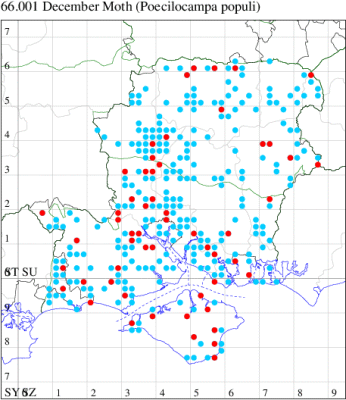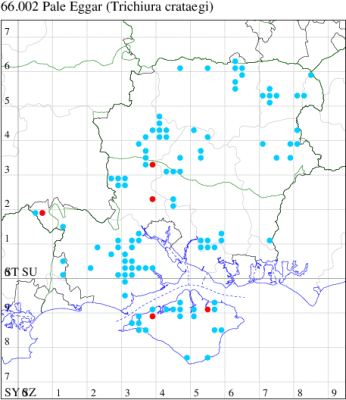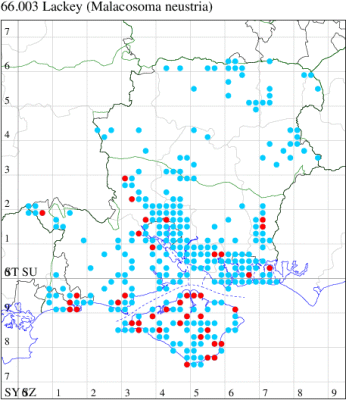2021 Annual Report for: Lasiocampidae / Poecilicampinae
For species seen in 2021 that had less than or equal to 100 records, full details are included; for more common species, the earliest, latest and highest count by vice-county are shown. The narrative for each species is taken from the main Hantsmoths website, and it is possible that some information on abundance and occurrence can get out of date, as it is impossible to keep up with all changes; however it should give a good introduction to each species. The tables in each species account summarise the previous status, and that for the current year.
For the maps, all records prior to 2021 are shown by a blue dot (the larger the dot, the more recent), with the current year's records shown in red. As previous records are superimposed on any report for 2021, new sites have greater emphasis (i.e. will show as 'more red').
In the species accounts, an asterisk next to a location indicates a new 10km square record; earliest ever dates are highlighted in orange, and latest ever in red. Initials in the species accounts refer to the recorders listed here. Please get in touch if you identify any omissions or errors, in particular if you have records that have yet to be submitted. Details of how to submit records can be found here.
66.001 [B&F: 1631] December Moth Poecilocampa populi (Linnaeus, 1758) - Common
Common in woodland, scrub, hedgerows and gardens throughout much of the British Isles. In Hampshire and on the Isle of Wight widespread and common in wooded country in the three vice-counties, but doubtless still under-recorded because of the lateness of its flight period. Wingspan male 36-38 mm, female 42-48 mm. Unmistakable: no similar species fly so late in the year. Larva feeds on many deciduous tree species, including birch, oak, hawthorn and blackthorn.
Records prior to 2021
| Vice County | #Records | #Individuals | First Record | Last Record |
|---|---|---|---|---|
| 10 | 204 | 928 | 1978 | 2020 |
| 11 | 1400 | 4094 | 1945 | 2020 |
| 12 | 474 | 1593 | 1950 | 2020 |
2021 records
| Vice County | #Records | #Individuals | Max Quantity |
|---|---|---|---|
| 10 | 48 | 157 | 17 |
| 11 | 85 | 303 | 56 |
| 12 | 28 | 60 | 6 |

Records by year
Records by week (adult)
Records by week (larval)
Record Summary
VC10: Earliest: Bonchurch, 11 Jan, 2 (JHa) Latest: Bonchurch, 31 Dec, 4 (JHa) Max count: Shanklin, 16 Dec, 17 (IOut)
VC11: Earliest: Botley, 11 Jan, 1 (SLB) Latest: Ashley Heath, 24 Dec, 1 (SDut) Max count: Botley Wood, 03 Dec, 56 (RJD, MLO, DWal, KJW)
VC12: Earliest: Blackwater, 29 May, 1 (BDal) Latest: Alton, 14 Dec, 2 (NDP) Max count: Hammer Vale, 13 Dec, 6 (ASwa)
66.002 [B&F: 1632] Pale Eggar Trichiura crataegi (Linnaeus, 1758) - Common
Local and declining in open woodland, hedgerows, heathland, moorland, scrub and gardens throughout much of the British Isles, a species of conservation concern under the UK Biodiversity Action Plan. In Hampshire and on the Isle of Wight has largely recovered from a decline in population evident in the 1990s. Wingspan 33-40 mm. Flight-time and coloration are diagnostic. Larva feeds on Blackthorn, Hawthorn, Silver Birch, Downy Birch, Heather and Bilberry, over-wintering as an egg.
Records prior to 2021
| Vice County | #Records | #Individuals | First Record | Last Record |
|---|---|---|---|---|
| 10 | 127 | 250 | 1856 | 2020 |
| 11 | 137 | 153 | 1951 | 2020 |
| 12 | 79 | 109 | 1951 | 2019 |
2021 records
| Vice County | #Records | #Individuals | Max Quantity |
|---|---|---|---|
| 10 | 2 | 2 | 1 |
| 11 | 6 | 9 | 3 |

Records by year
Records by week (adult)
Records by week (larval)
Record Details
VC10: Cranmore, one, 03 Sep (CHic); Wootton Bridge, one, field observation, worn specimen, 13 Sep (DElm det. IOut);
VC11: Romsey, two, 30 Aug (NRJ); Winter Down Copse, Little Somborne, three, 01 Sep; one, 01 Sep; one, 01 Sep; one, 01 Sep; one, 01 Sep (GCE)
66.003 [B&F: 1634] Lackey Malacosoma neustria (Linnaeus, 1758) - Common
Common on heaths, gardens and open woodland in the southern half of England, Wales and Ireland, a species of conservation concern under the UK Biodiversity Action Plan. In Hampshire and on the Isle of Wight widespread and usually fairly common in the three vice-counties, the gregarious larvae still a familiar sight, though certainly much less so than 30 years ago. Wingspan male 32-36 mm, female 40-44 mm. Similar to Ground Lackey M. castrensis, which see for differences. Larva feeds on various broad-leaved trees and shrubs, including Hawthorn, Blackthorn, Plum, Apple and Cherry, living gregariously within a silken web, over-wintering as an egg.
Records prior to 2021
| Vice County | #Records | #Individuals | First Record | Last Record |
|---|---|---|---|---|
| 10 | 673 | 1482 | 1909 | 2020 |
| 11 | 4279 | 13811 | 1948 | 2020 |
| 12 | 120 | 245 | 1951 | 2020 |
2021 records
| Vice County | #Records | #Individuals | Max Quantity |
|---|---|---|---|
| 10 | 55 | 111 | 8 |
| 11 | 68 | 167 | 40 |

Records by year
Records by week (adult)
Records by week (larval)
Record Summary
VC10: Earliest: Ventnor, 23 May, 0 (RJhn) Latest: Newport, 23 Aug, 1 (DPl) Max count: Plaish, Carisbrooke, 22 Jul, 8 (KRyl)
VC11: Earliest: Fareham, 14 Jun, 0 (iNat) Latest: Horndean, 14 Aug, 2 (PHog) Max count: Hengistbury Head, 17 Jun, 40 (RPH)